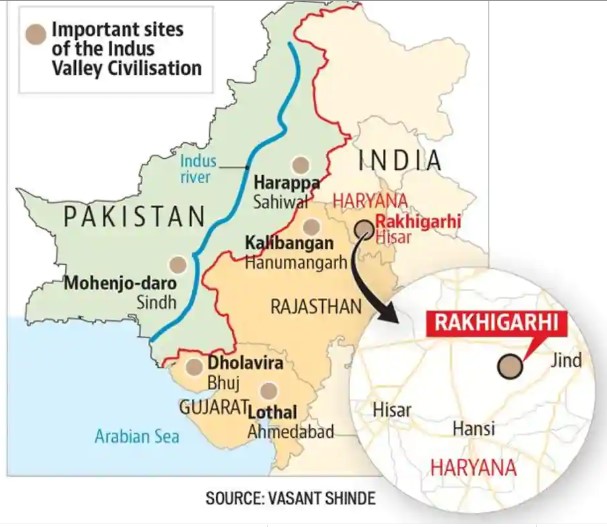Context:
DNA samples collected from two human skeletons unearthed at a necropolis of a Harappan-era city site in Rakhigarhi, Haryana have been sent for scientific examination.
- DNA analysis might tell about the ancestry and food habits of people who lived in the Rakhigarhi region thousands of years ago.
Relevance:
GS I- Ancient History
Dimensions of the Article:
- About Rakhigarhi
- Major findings at Rakhi Garhi
- What is the relevance of Harappa in today’s world?
About Rakhigarhi
- Rakhigarhi, Rakhi Garhi (Rakhi Shahpur + Rakhi Khas), is a village in Hisar District in the state of Haryana in India, situated 150 kilometers to the northwest of Delhi.
- It is the site of a pre-Indus Valley Civilisation settlement going back to about 6500 BCE.
- Later, it was also part of the mature Indus Valley Civilisation, dating to 2600-1900 BCE.
- The site is located in the Sarasvati river plain, some 27 km from the seasonal Ghaggar river.

- The size and uniqueness of Rakhigarhi has drawn much attention of archaeologists all over the world.
- It is nearer to Delhi than other major sites, indicating the spread of the Indus Valley Civilization east across North India.
- In May 2012, the Global Heritage Fund, declared Rakhigarhi one of the 10 most endangered heritage sites in Asia.
- There are many other important archaeological sites in this area, in the old river valley to the east of the Ghaggar Plain. Among them are Kalibangan, Kunal, Haryana, Balu, Haryana, Bhirrana, and Banawali.
Major findings at Rakhi Garhi
- The discovery of 4,600-year-old human remains, fortification, and bricks confirms both early and mature Harappan stages.
- So far, digging has revealed a well-planned city with roadways that are 1.92 metres wide, slightly broader than in Kalibangan.
- Pits with walls around them have been discovered, which are thought to be used for sacrificial or religious events.
- The sewage from the houses is handled by brick-lined sewers.
- Also discovered were terracotta figures, weights, bronze objects, a comb, copper fish hooks, needles, and terracotta seals.
- A bronze jar with gold and silver decorations has been discovered.
- A granary from the mature Harappan phase was discovered here.
- In Rakhigarhi, structures for fire altars were discovered.
What is the relevance of Harappa in today’s world?
- Harappan civilisation is amongst the first major urban civilisation that stretched over an area of 1.5 million square kilometres (the size of a modest sized modern country).
- It was highly standardised architecture, art and utilitarian items.
- It traded over an even larger area, getting raw material and exporting (to region where its standardisation rules did not apply) finished products, traders and some of its habits to different regions.
- The occurrence of the first civilization from which the emergence of the city and urbanism can be understood
- Their expertise in town planning, water management and harvesting systems as well as drainage mechanism is unparalleled.
- They had public and private wells at most of their sites and their houses were often equipped with bathing areas and toilets.
- They were also technologically very advanced in pyrotechnics and metallurgy.
- Their craftsmanship is evident in their beads, jewelry, pottery, seals as well as other artifacts made of metals and their alloys.
- Their trade networks were also quite widespread.
- They had standardized weights and measures.
- They often used standardized bricks in their architecture.
- Recent research has suggested that Harappan people were probably the first ones to introduce silk and lost-wax casting techniques.
- No large-scale weapons have been discovered from the Harappan sites which also suggests that they did not indulge in warfare.
- It post-dated the great cultures of Mesopotamia and was contemporaneous to Sumerian cultures.
- However, it received a lot of ideas also from Central Asia and in many ways, it collected the finest of ideas and technologies.
- Among other things, the Harappan civilization provides important insights into the relationship between civilizational collapse, violence, and disease.
- Global bodies and governmental organizations seeking to make predictions about global warming in the contemporary context have essentialized the relationship between climate change, environmental migration, and violence.
- In that sense it is relevant and important.
-Source: The Hindu



